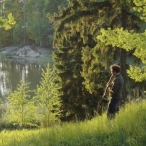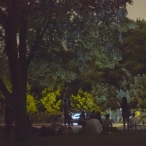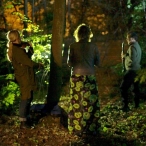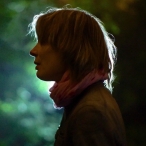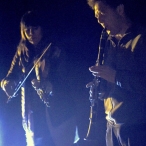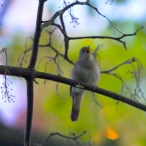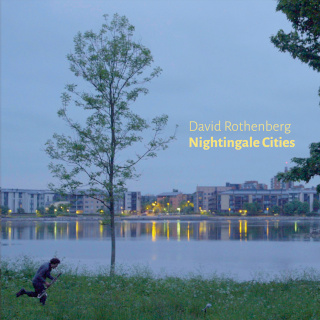
Nightingale Cities | David Rothenberg
Gruen 189 | Double CD > [order]
Reviews
Five years in the making, David Rothenberg’s Nightingales in Berlin project includes a book, a film, many live concerts, and this double CD, including a 20 page color booklet of stills from the film and music not available in any form online. Here’s what Rothenberg says about the project:
“I used to make interspecies music largely on my own, seeing myself as some kind of individual explorer seeking out musical ideas with creatures we can’t even talk to. But in recent years I’ve decided that the point of musical contact with another species is to convince other people to join me. Over five years, from 2014 through 2019, I invited the best and most adventurous musicians I know to connect in musical collaboration—humans with nightingales, in Berlin and Helsinki.
The nightingales have helped me find the perfect sound. By assembling just the right group of kindred spirits, together we dream of a way that humans and nature might live closer together. Our species is warming the planet beyond recognition, and this could mean the end of our reign over this place. Yet there are still these moments during which humans can touch nature through sound happening all around us, as we make music along with the nightingales of Helsinki and Berlin. The paths to animal music sit right before us.
I love to listen to different musicians respond to the song of the nightingale for the very first time. I have played with these birds for several years now, and sometimes I wonder why I keep trying to make music with musicians with whom I cannot speak, who live as birds—such different lives than people who may join the band. Some human critics think it’s all delusion, that I intrude upon the birds’ ancient world of perfect sound and struggle, but whenever I bring a new musician along to play with nightingales, I realize why I began this process in the first place. We all feel such joy and hope when music can carry meaning from one species to another. The planet becomes a more harmonious place.”
Nightingale Cities
Emil Buchholz, bass
Korhan Erel, iPad
Wouter Jaspers, Field Kit
Lembe Lokk, voice
Benedicte Maurseth, Hardanger fiddle
Wassim Mukdad, oud
Jay Nicholas, electric bass in remix
Volker Lankow, frame drum
David Rothenberg, clarinet, bass clarinet, seljefløyte, iPad
Sanna Salmenkallio, violin
Cymin Samawatie, voice
Ines Theileis, voice
Disc One, Berlin (72 minutes)
1. The Boori Sound
2. Dreaming Slow
3. While Birds Chant Praises
4. O Bülbul, Your Love
MP3
5. The Nightingales Are Drunk
6. Viktoria’s Dream
7. Nightingale Cities
8. Addicted to Birds
9. She’s Finally Here
10. At Midnight We All Waited
MP3
11. I Cannot Go Home
12. Exit Music
13. Nightingale, You Are the One
Disc Two, Helsinki (69 minutes)
1. Elektro Repeet
MP3
2. Sharawaji Blues
3. Willow Wind
4. No One Sings at Dawn Alone
5. Ballad with Nightingale and Mosquitoes
6. Sisichak
7. Sisichak Remix [for Emu]
MP3
8. Alien Beauty
9. The Morning Electric
10. Sotavalta’s Satakieli
11. NeoNachtigall
24 Tracks (141′00″)
Double CD (500 copies)
20 page color booklet
In the green midnight by the nightingale’s northern limit. Heavy leaves hang in trance, the deaf cars race toward the neon-line. The nightingale’s voice does not step aside, it’s as piercing as a cock-crow, beautiful without conceit. I was in prison and it visited me. I was sick and it visited me. I didn’t know it then, but I do now. Time streams down from the sun and the moon into all the tick-tock-thankful clocks. Right here there is no time. Only the nightingale’s voice, the raw ringing tones that whet the night sky’s gleaming scythe. – Tomas Tranströmer, „The Nightingale at Badelunda“
Photos by Ville Tanttu,
stills from his film Nightingales in Berlin
Produced by David Rothenberg together with his book,
Nightingales in Berlin (University of Chicago Press, 2019)
www.nightingalesinberlin.com
Recorded live on location in Germany and Finland 2014-2018
by David Rothenberg, Ville Tanttu, and Reelika Ramot
Mixed and mastered by David Rothenberg
at B Street, Cold Spring and NOTAM, Oslo.
© & ℗ 2019
All titles published by Mysterious Mountain Music (BMI)
All rights reserved.
Terra Nova Music – TN1920
Sound Art Series by Gruenrekorder
Germany / 2019 / Gruen 189 / LC 09488
Ed Pinsent | The Sound Projector
Clarinettist and sound artist David Rothenberg made the Cicada Dream Band record for Gruenrekorder in 2014 (with Pauline Oliveros and Timothy Hill); that record made use of insects and birdsong as part of its conceptual whole. A similar approach is used on Nightingale Cities (GRUENREKORDER Gruen 189), a double CD set of music recorded in Berlin and Helsinki. The nightingale is the key. Rothenberg claims this particular bird has “helped me to find the perfect sound”. He enlisted the help of various musicians and singers, plus field recording technicians, and they went out and played in the raw, creating music right there in the forests along with the song of the nightingales. The sessions have been thoroughly documented in the fat book of notes – photographs and annotations galore, meticulously detailing the circumstances of each separate track. Yet the results aren’t really that great to listen to, and there’s a rather twee vibe to the whole thing (bad poetry and much mutual self-admiration among the players), but Rothenberg may be onto something with his ideas about “interspecies music”. It’s a fairly imaginative way of engaging with the ecological debate, for one thing.
link
David Rothenberg | Nightingale Cities @ The Guardian
Why nightingales are snubbing Berkeley Square for the Tiergarten
Scientists, including a descendant of Charles Darwin, are researching the birds’ preference for Berlin — by Philip Oltermann
Łukasz Komła | #Kwartlanik Przekrój
David Rothenberg to amerykański klarnecista, kompozytor, profesor filozofii, absolwent Harvardu, a także wykładowca w New Jersey Institute of Technology. Autor wielu interesujących książek, np. Why Birds Sing (2005) i Thousand Mile Song (2008) oraz filmów dokumentalnych, w których opisuje i bada muzykę przez pryzmat świata zwierząt.
W 2014 r. ukazał się niesamowity album Cicada Dream Band nagrany przez Pauline Oliveros, Davida Rothenberga i Timothy’ego Hilla, na którym znalazły się improwizowane nagrania w otoczeniu odgłosów cykad, świerszczy, humbaków, żab i ptaków. Rok później Rothenberg zainicjował w Berlinie projekt skupiający się wyłącznie na śpiewie słowików. Wraz z tureckim eksperymentatorem Korhanem Erelem odbył wycieczki po berlińskich parkach w poszukiwaniu odgłosów tych ptaków, po czym obaj nawiązywali ze słowikami interaktywne porozumienie. Efekty tych niecodziennych zabiegów pojawiły się na płycie Berlin Bülbül (Gruenrekorder, 2015). W kolejnych latach Amerykanin wydał książkę i nakręcił film związany z tym przedsięwzięciem.
Najnowsze i podwójne wydawnictwo Rothenberga Nightingale Cities podsumowuje jego pięcioletnią przygodę z berlińskimi i helsińskimi słowikami. Przy tym projekcie pracowali także inni artyści, których zaprosił Rothenberg (grający na klarnecie basowym, seljefløyte i obsługujący iPada), czyli: Emil Buchholz (bas), Korhan Erel (iPad), Wouter Jaspers (field kit), Lembe Lokk (śpiew), Benedicte Maurseth (hardanger fiddle), Wassim Mukdad (oud), Jay Nicholas (bas elektryczny), Volker Lankow (bęben ramowy), Sanna Salmenkallio (skrzypce), Cymin Samawatie (śpiew) i Ines Theileis (śpiew).
Rothenberg od początku zgłębiał prace niemieckiej ornitolożki Silke Kipper, która od wielu lat bada dźwiękowy aspekt śpiewu słowika i towarzyszące temu różne zawiłości, polegające m.in. na odmiennych tonacjach, jakie wydają z siebie samiec lub samica w różnych okresach życia. Warto mieć na uwadze, że wiosenne miesiące (kwiecień–maj) to doskonały moment na rozpoczęcie obserwacji słowików przylatujących z Afryki. Możemy je spotkać w prawie całej Europie i nie tylko. Śpiew tego ptaka jest niezwykle donośny, urozmaicony i ma dużą skalę tonów. Pierwsza płyta Nightingale Cities jest zapisem „współpracy” z berlińskimi słowikami. Ta część wydawnictwa powstała głównie w dzielnicy Kreuzberg. 13 fragmentów o minimalistycznym zarysie wprowadza w medytacyjny nastrój. Pomagają w tym delikatne partie klarnetu Rothenberga i oniryczny śpiew Lembe Lokk.
Słowicze trele są oczywiście najważniejsze, bo to wokół nich kręci się podmuch improwizowanego powietrza płynącego z instrumentów czy ludzkiego gardła. Niekiedy towarzyszem staje się też dźwięk wygenerowany z iPada. „Słowiki pomogły mi znaleźć idealny dźwięk – opowiada Rothenberg. – Gatunek ludzki ociepla planetę nie do poznania, a to może oznaczać koniec naszego panowania nad tym miejscem. Nadal jednak są chwile, w których ludzie mogą dotykać przyrody poprzez dźwięki rozgrywające się wokół nas, choćby tworząc muzykę wraz ze słowikami”.
Druga płyta z tego zestawu w całości poświęcona jest helsińskim słowikom i współpracy z tamtejszymi muzykami. Tutaj z kolei w przeważającej części materiału Rothenberg sam nawiązuje dialog z ptakami – robiąc to za pomocą klarnetu lub klarnetu basowego, iPada oraz tradycyjnego norweskiego fletu seljefløyte (w wolnym tłumaczeniu: gwizdek na foki). Zdarza się, że do słowiczego świata artysta przemyca jazzową, bluesową i orientalną frazę.
Trudno rozpatrywać Nightingale Cities w kategoriach czystego field recordingu, gdyż nie o taką filozofię dźwięku chodziło Rothenbergowi. Amerykańskiego kompozytora bardziej interesuje żywy kontakt z przyrodą niż skupianie się na dokumentalistyce. Być może będzie to zbyt daleko idąca paralela, ale wydaje się, iż działania Rothenberga są bliskie twórczości Luca Ferrariego (1929–2005). W kontekście Nightingale Cities przypomniał mi się wznowiony dwa lat temu album francuskiego kompozytora Hétérozygote/Petite symphonie. Szczególnie wiążę Nightingale Cities z ideą Petite symphonie. Ferrari tym nagraniem wyraził swój zachwyt nad zachodem słońca, w czasie pobytu w górach, gdzie na szlaku spotkał pasterza, a ten mu odpowiedział: „Nigdy się nie nudzę, bo wsłuchuję się w krajobraz. Czasami gram na flecie i wówczas nasłuchuję echa, które mi odpowiada”. Podobnie jest ze śpiewem słowika, nie ma w nim powtórzeń, przewidywalności i ustalonej z góry linii melodycznej, więc nie ma tu mowy o nudzie.
Nightingale Cities wyśmienicie zaciera granice między przyrodą a człowiekiem oraz skłania do głębokiej refleksji nad kondycją ludzkości. Rothenberg swoimi muzycznymi działaniami kreuje wyabstrahowaną rzeczywistość, tym samym zaprasza nas do budowania symbiozy ze światem będącym na wyciągnięcie ręki. Dla jednych natura jest cennym źródłem doświadczeń, dla innych – i niestety większości z nas – pozostaje zbędnym dodatkiem. Śpieszmy się słuchać przyrody, która nieustannie wysyła wyraźne sygnały. David Rothenberg doskonale rozkodował i udźwiękowił ten przekaz.
link
(DM) | VITAL WEEKLY
David Rothenburg is building up an interesting life work. He is working on ‘interspecies music’! Several of his earlier projects for Gruenrekorder, a German label specialised in field recordings, soundscapes and sound art, has been reviewed here. But with this new release, it started to work for me what Rothenberg is exploring. This project took five years (2014-2018), doing recordings in Berlin and Helsinki, including a book as well as a documentary. Gruenrekorder again releases this double CD, with a 20-page booklet included. Disc one has 72 minutes of recordings done in Berlin. For disc two we are 69 minutes in Helsinki. As a composer and clarinettist with roots in jazz, to make music with birds became a fascination that never left him. At the same time, it remains a mystery for Rothenberg himself what attracts him in this possible communication that can never be proven. His research on the relationship between music and birds is what made Rothenberg known as an expert in this field. On earlier recordings, it was always just Rothenberg and the birds. This time he invited musicians to participate: Emil Buchholz (bass), Korhan Erel (iPad), Wouter Jaspers (Field Kit), Lembe Lokk (voice), Benedicte Maurseth (Hardanger fiddle), Wassim Mukdad (oud), Jay Nicholas (electric bass in remix), Volker Lankow (frame drum), , Sanna Salmenkallio (violin), Cymin Samawatie (voice) and Ines Theileis (voice). David Rothenberg plays the clarinet, bass clarinet, seljefløyte and iPad. Rothenberg: “The nightingales have helped me find the perfect sound. By assembling just the right group of kindred spirits, together we dream of a way that humans and nature might live closer together. Our species is warming the planet beyond recognition, and this could mean the end of our reign over this place. Yet there are still these moments during which humans can touch nature through sound happening all around us, as we make music along with the nightingales of Helsinki and Berlin. The paths to animal music sit right before us.” Most of the tracks have a clear recording of a nightingale, with few other environmental sounds. For his recording in Berlin, Rothenberg is assisted by two or three musicians. The Helsinki recording has him solo. So what is it that we are listening to? A one-sided communication, blinded by idealism? Anyway, it is a very specific and consciously chosen musical response to aspects of our environment that starts with a close listening, driven by curiosity what nature and environment produce. In this case, the phrases produced by the nightingale. A sympathetic and sometimes touching enterprise! The last track is a surprising one; a long one with some ‘real’ music. A computer-generated beat, with a bass solo by Jay Nicolas. And ‘Nightingale as a machine, machine as a nightingale’, Rothenberg explains. (DM)
link
Duncan Simpson | Musique Machine
Philosopher and musician David Rothenberg has had a fascinating and singular career. Through his many books and recordings Rothenberg has forged a niche for himself as something of an interspecies musicologist. Beginning with his first book Why Birds Sing: A Journey Into the Mystery of Bird Song he has explored both human and animal relationships to sound and the environment by way of mutual song. This has on several occasions – as it does here on his fourth outing for Gruenrekorder – taken the form of actually playing along with the calls of animals. Nightingale Cities is a sprawling 2CD collection of recordings of Rothenberg and others improvising with those birds in and around Berlin and Helsinki. The release coincides with the publication of a book of the same name.
The first disk, recorded in Berlin, features the largest group of improvisers, including the voices of Lembe Lokk and Cymin Samawatie , Korhan Erel on iPad electronics and even an oud played by Wassim Mukdad. For the most part though, and exclusively on the second disk recorded in Helsinki, it’s the clarinet and electronic manipulations of Rothenberg himself, alongside the beautifully recorded calls of the nightingale. Recording with a wild animal makes the notion of rehearsal somewhat redundant, and so what we have here are two collections culled from multiple improvisation sessions, and as you might expect this produces a mixed set of results. Indeed the players seem to be finding their feet on some of the early tracks starting with The Boori Sound and Dreaming Slow where Lokk interjects with the Nightingale in a call and response fashion.
Undoubtedly, the sound initially strikes the ear as odd; sparse, with the bird calls allowed centre stage and the other instrumentalists joining and leaving as they see fit. Things begin to come together on the longer pieces that make up the middle of disk 1. O Bulbul, Your Love and The Nightingales are Drunk both feature more varied and active interventions from the ensemble; in particular Korhan Erel’s iPad electronics which scatter distant percussive trills and fragments of pre-recorded acoustic instrumentation across the mix, lending these piece an extra depth that has you forgetting they are being recorded outdoors. The latter composition is subtly layered with recycled phrases from the clarinet and Lokk’s voice. Though the nightingale sounds sober, there’s a blurred, pleasantly inebriated drift to the ensemble’s playing that’s almost dream like; with Rothenberg’s clarinet oozing out several memorable melodic phrases. The album title track is another highlight with Cymin Samawatie on voice, her serpentine Persian lyrics dovetailing (pardon the pun) superbly with Erel’s electronics, which at times are redolent of Akira Rabelais‘ classic Spellewauerynsherde. The disk closes with an amusing incident when the Berlin police show up, no doubt to find out who these odd people are recording with the birds at 1am!
The second disk, recorded in Helsinki, features Rothenberg almost entirely solo with a variety of instruments and noise makers including reed warblers and an ancient Norwegian flute called a seljefløyte. Rothenberg muses in the sleeve notes: „Does the bird get this?“. Certainly they should be able to comprehend if they’re able to make something of the composer firing their own calls back to them in reverse or at slow speeds, as he does with the aid of the iPad on Elektro Repeet. All the tracks on the second disk bar the last one were recorded during a single trip to Helsinki in 2016 and thus benefit from a greater degree of consistency in approach compared to the first disk which features recordings made over several years. Rothenberg shifts for each track from one set of instruments to another. From his clarinet to the seljefløyte and from there onto a furulya (a type of recorder), bass clarinet, electronics and the warblers. It’s tempting to hear more synergy between the human and animal parts of this project than are perhaps actually present. Then again jazz and contemporary composition are full of dissonant recordings where one wonders if the players were in the same time-zone, let alone the same room when they recorded it.
There’s a surreal, almost whimsical side to this project which has a grown man going outside to play along with the birds. But as you listen to these pieces and the bird calls begin to slide in an out with the players it begin to click and you can imagine that impromptu ensembles of blackbirds, nightingales and humans are indeed striking up a most occult kind of jazz music. Ballad with Nightingale and Mosquitoes adds violin to Rothenberg’s clarinet; the strings intervening as short bursts darting around the calls of nightingale, which actually seems to lead the other two players with constant shifting between tonal and textural sounds. If you focus your attention on the birds you can see why someone might want to attempt a recording of this type. The range and clarity of their calls is extraordinary, going from repetitive chirps to melodic riffs, percussive trills and many sounds difficult to describe. The last track on the album is a departure from what went before. It’s a studio composition using bass guitar to accompany Rothenberg’s computer manipulated recordings of the nightingales. Consequently it lacks all the beautifully naturalistic quality of the previous tracks. It’s a fun listen with the bird calls warped into loops or animated into more easily controlled samples.
At nearly two and a half hours of music Nightingale Cities is a sprawling culmination of a project that’s clearly very close to Rothenberg’s heart. There is material, particularly on the first disk, that manages to raise itself above the slightly whimsical premise of the project. However, many of the recordings here fail to hold the attention for those not versed in the complexities of ornithological vocalisation, and with the variety of material, it perhaps could have done with being distilled a bit more into a single disk. As it stands, Nightingale Cities is a record to get lost in, slightly baffled and occasionally come across a real gem of interspecies synergy.
link
textura
On Nightingale Cities, clarinetist David Rothenberg expands on the duet approach of his earlier ‘interspecies‘ recordings by including others. To that end, he and like-minded musicians collaborated with nightingales in Berlin and Helsinki over a five-year period, the results documented in this double-CD release (a companion to the recording is Rothenberg’s 2019 book Nightingales in Berlin). One of the best things about this unusual project is that it’s not field recordings-based in the usual sense: a recording of that kind typically sees the artist collecting sounds from the environment and merging them with material, musical or otherwise, generated at a different place and time; in Rothenberg’s case, interactions with nature, in this case nightingales, happen live and are recorded in real-time. (His music projects involving non-human species haven’t centered on birds exclusively, by the way, but also have included ones with whales and bugs.)
Along with Hardanger fiddler Benedicte Maurseth, bassist Emil Buchholz, frame drummer Volker Lankow, oud player Wassim Mukdad, and violinist Sanna Salmenkallio, singers appear (Lembe Lokk, Cymin Samawatie, Ines Theileis) while Rothenberg (in addition to clarinets) and Korhan Erel are credited with iPad and Wouter Jaspers Field Kit. Complementing the two CDs (one documenting the Berlin recordings, the other Helsinki’s) is a twenty-page booklet containing photos plus track listings accompanied by details about personnel, dates, and locations. Groupings of three, four, and five participants perform (nightingale included) on most of the Berlin tracks, whereas eight of the eleven Helsinki pieces are Rothenberg duets. That set also supplements the sounds of the Thrush nightingale with those of the sedge warbler, blackbird, reed warbler, and mosquito, and two album tracks present the nightingale unaccompanied.
A typical setting presents the leader on clarinet accompanied by two or three others and a nightingale interacting with all of them. The performances unfold in an unhurried, methodical manner, the humans receptive and responsive to the expressions arising from all concerned. The amazing to-and-fro that occurs between Lokk and the nightingale during “Dreaming Slow” should lay to rest any doubt that the bird’s expressions are not in some way responses to the singer’s. Much the same might be said of the title track, which sees the birds reacting to Samawatie’s musings, Erel’s eerie textures, and Rothenberg’s explorations.
The sound design has the potential to expand limitlessly beyond acoustic borders when the iPad’s involved. With the leader generating warbling synthesizer-like noises, “Alien Beauty,” for instance, is hardly like something one would imagine originating out of a Helsinki park. The ear otherwise perks up when the sweetly rustic sound of the Hardanger fiddle surfaces alongside the clarinet and nightingale during “She’s Finally Here.” With frame drum prodding the music along, the ensemble becomes a folk-tinged septet for “At Midnight We All Waited,” and then takes on a bluesy Eastern character when oud and frame drum appear in “I Cannot Go Home.” One particularly amusing moment arises during “Exit Music” when at one in the morning the musicians are asked to leave a Berlin park and thereafter play no later than ten o’clock at night.
On disc two, Rothenberg’s wail on the duet “Sharawaji Blues” sounds like he might have been imagining himself playing at a jazz club as opposed to a Helsinki park. In “No One Sings at Dawn Alone,” the Thrush nightingale turns particularly animated and talkative when paired with the leader’s bass clarinet, after which Rothenberg comes close to matching the musical chirp of the Blyth’s reed warblers during “Sisichak” when he plays a Bulgarian double whistle called the furulya. In terms of outliers, Nightingale Cities ends on a rather bizarre note when the insistent throb of Jay Nicholas’s bass powers a grooving dance pulse through the nightingale-punctuated “NeoNachtigall.”
At twenty-four tracks and 141 minutes, the question invariably arises: wouldn’t a single CD of, say, one-hour-long duration suffice? Yes, it would, but there’s also something undeniably engrossing about the result, even in its unabridged form. If anything, as the recording advances one’s affection for the project grows, especially when the ‘music‘ produced by the birds is so mesmerizing and the normal barriers separating the species seem to dissolve. As the recording nears its end, you’ll likely find yourself having been won over by Rothenberg’s contention that when humans create music with another species “(t)he planet becomes a more harmonious place.”
link
Rigobert Dittmann | Bad Alchemy Magazin (102)
DAVID ROTHENBERG ist Klarinettist, erprobt im Spiel mit Scanner, Pauline Oliveros, Iva Bittová, Marilyn Crispell, er ist Professor of Philosophy and Music und er ist der Autor von „Sudden Music: Improvisation, Sound, Nature“ (2002), „Why Birds Sing“ (2005), „Thousand Mile Song: Whale Music in a Sea of Sound“ (2008), „Survival of the Beautiful: Art, Science, and Evolution“ (2011) oder „Bug Music: How Insects Gave Us Rhythm and Noise“ (2013). Lauter Bücher mit Musik. Zu seinem neuesten, „Nightingales in Berlin“, gehört Nightingale Cities: Berlin / Helsinki (Terra Nova, TN 1920 / Gruen 189, 2 x CD), aber auch schon „Berlin Bülbül“ (TN 1511 / Gruen 159). Beides mit Electronics von Korhan Erel, Rothenberg mit auch noch Bassklarinette, Seljefløyte, Furulya oder iPad, sowie nun auch noch den Sängerinnen Lembe Lokk & Cymin Samawatie, der Geigerin Sanna Salmenkallio und weiteren Berliner Bülbüllauschern, die sich die Nächte um die Ohren schlugen, um mit Nachtigallen zu musizieren. Deren Musik der Dichter John Clare schon 1832 bewundernd einfing mit ‘Chew-chew chew-chew’ & higher still / ‘Cheer-cheer cheer-cheer’ more loud & shrill / ‘Cheer-up cheer-up cheer-up’—& dropt / Low ‘Tweet tweet jug jug jug’ & stopt / One moment just to drink the sound / Her music made. So suchte Rothenberg, meist allein, im Mai 2016 in Helsinki auch den Zusammenklang mit Sprossern, Busch- & Schilfrohrsängern (mit Amsel oder Wachtelkönig als akustischem Beifang). In der Überzeugung, dabei nicht einem ‚Anderen‘ als ‚Alien Beauty‘ zu begegnen, vielmehr einem Widerhall menschgemachter Klänge, hard machinery ebenso wie soft melody. Natur und Kultur verklammert durch Schönheit als evolutionärem Plus? Mit anfänglichen Finessen- und Verblüffungsvorteilen der Geschnäbelten, denen dennoch ob des unmöglichen Dus die Rolle von Accessoires und Lokalkolorit droht. Am Ich-Du-ähnlichsten ist es, wenn Rothenberg unter finnischem Himmel und unter vier Augen quasi selber zum Vogel wird.
link
Richard Allen | a closer listen
David Rothenberg is a musician with a calling: to hear, appreciate, and participate in the music of the animal kingdom. A triptych of books on whale music, bird music and bug music has cemented his reputation. In 2019 he returns with a defined focus ~ the music of the nightingale ~ and this time, he’s brought friends, who play everything from frame drum to laptop (playing the birdsong of the nightingales back to the nightingales). Nightingale Cities is the two-disc facet of this release, while Nightingales in Berlin is the title of the book and film, all premiering this spring.
“The biggest thing is to not play ~ just listen.” says Rothenberg. “Listen most of the time.” The opening statement of the trailer sets us at ease. It’s easy to dismiss the thought of interspecies music as fancy or hubris. But if such a thing can happen, it begins with humility. People have conversations with dogs, cats and parrots all the time. So why not music? Some claim that the difference in auditory systems prevents such interactions from happening, or that our music is merely tolerated or ignored by other species. Others show that certain animals demonstrate a preference for certain types of music, or at east an aversion to others. Rothenberg’s “Eleven Paths to Animal Music” elucidates his approach. He thinks that he and his friends are performing duets, while realizing that this might be wishful thinking; yet he also apologizes for his earlier criticism of scientists, who are in fact attempting to prove his theories (while occasionally fighting over a single bird).
So let’s begin with a few basic assumptions: 1) Certain members of the animal kingdom might be willing and able to duet with humans; 2) Listening closely to the sounds of other living creatures increases our overall awareness; and 3) Even if the duets are never proven, the idea of the duet is enough, as Cymin Samawatie extols, to make us feel “connected … maybe even to God.”
The nightingale is capable of producing innumerable vocal phrases, many of which can be heard here. While listening, one begins to anthropomorphize, thinking, “that part sounds like electronic music” or “is this free jazz improv?” It’s not. It’s birdsong. But one may also connect the ability to that of a newborn human infant, whose vocal repertoire seems endless, and virtually impossible to imitate. Different cultures reward different sounds with repetition, losing the ability to mimic what is not reinforced. It’s fun to watch Rothenberg as he attempts to imitate the nightingale’s growl. While clearly in love with the nightingale’s phrases, he calls them “weird,” but also admits that people have had the same reaction to his own music.
The full title of the book is Nightingales in Berlin: Searching for the Perfect Sound. Such a search is clearly subjective. A favorite sound is another. When Rothenberg chooses one particular utterance as the nightingale’s “best note,” we know he’s winking. In like fashion, he asks, “How can we tell if one soundscape is better than another?” It’s a question we face here all the time, as we do choose to review some soundscapes and not others, then rank them at the end of the year. But we know, as does Rothenberg, that our preferences are sometimes based on measurement (for example, the clarity of the recording ~ this one is pristine) and sometimes arbitrary (preferring dense recordings or sparse).
When listening to nightingales, one gravitates to one sound to another; when listening to a 140-minute collection of interspecies music, one prefers certain segments. The cacophony at the center of “O Bülbül, Your Love” strikes this listener as the album’s best distilled explosion of joy, the beginning of “The Nightingales Are Drunk” the most relatable soundscape, due to the sound of passing cars. On “Sisichak,” Rothenberg and furulya stumble into “a jam session of reed warblers” in Helsinki. Lemke Lokk’s interaction in “Dreaming Slow” is convincing on its own, even devoid of context; and amazingly, it’s been caught on film (see below). An exchange at the end of “Exit Music” humanizes the composer and his project: “Making music?” “No.” Meanwhile, Rothenberg amusingly notes that the nightingale provides no indication of when one song (track) ends and another begins.
But perhaps the most affecting juxtaposition happens offstage. On “Nightingale, You Are the One,” “finally, our bird can sing for himself, alone, no humans to trouble him.” (The same approach holds true for “Sotavalka’s Satakieli” on Disc Two.) At the same time, vocalist Samawatie is not allowed to perform in her home country of Iran. Nightingales may sing loudly in order to drown out their competition; only humans attempt to silence others completely.
link
Holger Adam | testcard
Draußen vor der Tür: Field-Recordings und Sound-Art von Gruenrekorder
Gruen, gruen, gruen sind alle meine Farben – bereits zum dritten Mal in Folge eine Gruenrekorder-Kolumne in testcard. Wie immer kommt man aus dem Staunen nicht heraus, wenn man sich die Veröffentlichungen des Frankfurter Labels anhört. Unerschrocken und ohne mit der Wimper zu zucken haben sie die Geräusche von laufenden Filmprojektoren auf Vinyl gepresst: Sounds Of The Projection Box heißt das Album von MICHAEL LIGHTBORNE und es dokumentiert das Rattern der Maschinen, deren Geräusche üblicherweise nicht aus der Kabine von Filmvorführern hinaus dringen. Geräusche, die vom Aussterben bedroht sind, weil Filme ja mehr und mehr digital an Lichtspielhäuser übermittelt und dort abgespielt werden. Insofern wird hier akustisches Kulturerbe archiviert, und wer die Platte auflegt, kann sich bei geschlossenen Augen in die Rolle des Filmvorführers imaginieren und zusätzlich versuchen, den Tonspuren bzw. -fetzen der ablaufenden Filme ein zusätzliches Narrativ abzuringen. Ähnlich abenteuerlich auch die Aufnahmen von GREGORY BÜTTNER, der für Voll.Halb.Langsam.Halt die Fahrt eines alten Dampfschiffes, eines Eisbrechers dokumentierte, bearbeitete und sein Vorgehen sowie das Ergebnis wie folgt kommentiert: „I had the chance to take a trip on the ship from Rostock to Rügen over the Baltic Sea in 2010. The body of the ship is completely built from metal, so it is a big resonant room which sounds very different on each spot which I put my contact mics on (I used two contact mics, so I could record in stereo). I walked around the ship, placing my mics on different areas of the ship and also directly on parts of the steam engine, which is still fired by coal. For the composition I only used the pure recordings without additional sound manipulations, only juxtapositions, transitions and cuts.” Alles klar? Der Kahn bzw. das, was Büttner aus seinen Geräuschen macht, kann locker mit Merzbow mithalten. Harter Stoff. Metallisch kühl, aber weniger krachend klingt auch Gasworks von GERALD FIEBIG feat. EMERGE & CHRISTIAN Z. MÜLLER. Der Ort als Resonanzkörper für Geräusche bildet das Ausgangsmaterial für diese CD. Entsprechend räumlich ist in der Tat viel von dem, was es zu hören gibt, organisiert: Echo und Hall spielen eine große Rolle im Klangbild – aber auch eine dialekt-gefärbte Stimme, die von der industriellen Nutzung des Gebäudes erzählt, kommt, ergänzt um Geräusche, zu Wort. So entsteht für das Gaswerk von Augsburg-Oberhausen ein Denkmal. Der gleichermaßen verspielte und dokumentarische Charakter der musikalischen Arbeiten verwandelt den frühindustriellen Arbeitsalltag in eine geisterhafte Klangreise: „Des gibt’s heut‘ nimmer.“ Bemerkenswert. Maschinenmusik ist auch auf der Slotmachine-10“ versammelt, einem Projekt von ACHIM ZEPEZAUER, der von unterschiedlichen Musiker*innen jeweils 45 Sekunden lange Klangskizzen anfertigen ließ, die in der Logik eines Spielautomaten und nach Zufallsprinzip geleichzeitig aufgerufen werden können. Realisiert ist das im Rahmen einer Online-Anwendung, die das Bedienen eines virtuellen Spielautomaten zur Erzeugung der Zufalls-Kompositionen zugänglich macht, hier: http://slotmachine.kuhzunft.com. Viel Spaß! (Die 10“ dokumentiert nur einen kleinen Teil der gewissermaßen unendlichen Kombinationsmöglichkeiten.) Auch KATHARINA KLEMENT liefert mit Peripheries, einem akustischen Portrait der Stadt Belgrad, eine quirlig-nervöse und herausfordernde Arbeit ab. Unter Zuhilfenahme des Stadtplans erstellte Klement eine kartographisch inspirierte Partitur. Verschiedene Lokalitäten in der Stadt wurden aufgezeichnet und ineinander gemischt. So entsteht ein wahres Klang-Gewimmel, das beizeiten wirklich anstrengend sein kann. Ich empfehle nach Selbstversuch folgendes: Die Aufnahmen auf dem Balkon abspielen und die Balkontüre offenlassen, während man im Zimmer bleibt. So entsteht der Eindruck, draußen sei Belgrad! Bei der Gelegenheit gebe ich gerne zu, dass mir im Zweifel die eher ruhigen Aufnahmen aus tropischen Gefilden lieber sind. F. Guyana von MARC NAMBLARD hilft sich vom Stress in Belgrad zu erholen. Allerlei hypnotisches Summen, Surren und Dröhnen der Flora und Fauna von der Nordküste Südamerikas! Auch DAVID ROTHENBERG hat wieder mit allerlei Vögeln Musik gemacht und sich für Nightingale Cities auch zusätzliche menschliche Instrumentalist*innen dazu geholt. Die in Berlin und Helsinki angefertigten Aufnahmen gehören sicherlich zum zugänglichsten Material in dieser Kolumne, die Vögel sind freundliche Wesen, die Musik ist es auch. Wer noch nie eine Gruenrekorder-Produktion gehört hat, kann vielleicht auf diesem Weg einen sanften Einstieg in den Katalog des Labels finden. Frühlingsmusik. Ganz anders und noch besser: die Windharfen-Aufnahmen auf Path Of The Wind von EISUKE YANAGISAWA. Windharfen, große Saiteninstrumente in die Brise gestellt, werden buchstäblich von der Natur gespielt und je nachdem, wo die Windharfen standen mischen sich unterschiedliche Umgebungsgeräusche unter die betörenden Klänge der Instrumente. Ambient Drone mit Seemöve. Minimal Music mit Meeresrauschen. Näher an New Age Klanglandschaften waren Gruenrekorder vielleicht nie, und es schadet nicht: Absolutes Highlight! Das Meer rauscht auch auf De Rerum Natura / Dance of the Elements von MERZOUGA, die nichts geringeres als eine Komposition auf Grundlage des Lehrgedichtes von Lucretius‘ wagen. Soweit so ambitioniert, aber da muss man sich nicht abschrecken lassen. Musik ist immer Ausdruck von Ideen, hier eben einer dezidiert philosophischen. Und elektronische Musik eignet sich auch nicht erst seit gestern, zur Verdeutlichung, mithin Vermittlung abstrakter Vorstellungen. Und so knistert es kleinteilig, die Atome tanzen unsichtbar aus den Lautsprechern, eine Stimme flüstert hier und da Versatzstücke in englischer und lateinischer aus dem Gedicht usw. – ein kurzeiliges, abwechslungsreiches und durchaus spannendes Hörerlebnis, das dem Überbau entsprechen mag; letztlich aber spielt es zum Genuss der Komposition keine entscheidende Rolle, würde ich meinen. Ähnlich gelagert ist es womöglich im Fall von The Secret Life of the Inaudible von ANNEA LOCKWOOD und CHRISTINA KUBISCH anzuhören. Die beiden Klangkünstlerinnen haben sich Soundfiles von an sich bzw. für Menschen nicht hörbaren geophysikalischen Phänomenen zur gegenseitigen Bearbeitung vorgelegt: elektromagnetische Wellen, Ultraschallwellen, Sonnenwinde… akustische Ereignisse also, die zunächst technisch in eine für das menschliche Ohr hörbaren Frequenzbereich überführt werden müssen und von Kubisch und Lockwood bearbeitet wurden, und die dann – wie auch immer das im Detail von Statten ging – daraus sozusagen dunkle Materie gewannen. Mich würde einmal interessieren, inwiefern, das geologisch-kosmische Quellenmaterial, wo es ohnehin in den hörbaren Bereich übersetzt und also synthetisiert werden muss, nicht auch anders, also mit weniger Aufwand, generiert werden könnte? Ich nehme behelfsweise an, es wäre nicht dasselbe! Wie dem auch sei, das Ergebnis fasziniert: Sunn O))) – Kindergarten dagegen. Finster dräuende, pechschwarze Klangflächen. Wahrhaft infernalische Musik aus dem Reich des sonst Nichtwahrnehmbaren. Hervorragend.
link
CD TIPP – Label: Gruenrekorder
Musik von David Rothenberg und Gerald Fiebig
Von Henry Kozok
Seit 2003 ist das deutsche Label Gruenrekorder zuständig für Fieldrecordings, Sound Art und vieles was nie in gängige Schubladen passt oder in die Kataloge des Online Handels. Wer interessiert sich schon dort für Musik aus dem alten Gasometer in Augsburg, den Gesang der Vögel in den Parks von Berlin und Helsinki? Lasse-Marc Riek und Roland Etzin interessiert es.
Aus Richtung Nürnberg mit der Bahn kommend fährt man in Höhe Augsburg-Oberhausen am Gasometer vorbei. Es ist nicht zu übersehen. Ein Zeugnis eines Industriezeitalters das der Vergangenheit angehört. Der Augsburger Gerald Fiebig hat in diesem Gasometer 2013 eine faszinierende Klanginstallation eingerichtet, welche auch die Grundlage der CD ist. Siehe hierzu auch die vielen Reviews dazu.
soundcloud.com/gruenrekorder/gasworks-gerald-fiebig-feat-emerge-christian-z-muller
Etwas ganz untypisches für Gruenrekorder wurde mit der Vogelmusik von David Rothenberg veröffentlicht. Was aber auch die ganze Bandbreite dieses Labels ausmacht. Mit dem Gesang der Vögel wurde in den Parks von Berlin und Helsinki musiziert, dort wo die Nachtigall noch singt … Jedenfalls bis 22.00 Uhr, dann muss Schluss sein. Musik nach 22.00 Uhr geht nicht und wenn sie noch so schön ist.
soundcloud.com/gruenrekorder/nightingale-cities-david-rothenberg
Für alle die sich einen Überblick über die Klangwelt von Gruenrekorder verschaffen wollen, sei hier die Soundcloud Seite empfohlen und der Text von Holger Adam auf Testcard, der bei fast allen Reviews zu den Gruenrekorder Veröffentlichungen zu finden ist !
Genannte Veröffentlichungen:
Gerald Fiebig feat. EMERGE & Christian Z. Müller: ‘Gasworks’
David Rothenberg: ‘Nightingale Cities’






